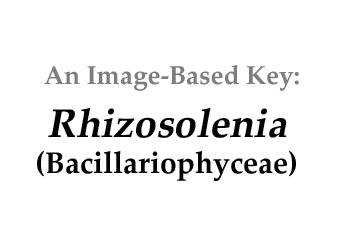|
Home / Diatoms / Centric / Unicells / Rhizosolenia |
||||
|
|
|
|||
|
|
||||
|
Click on images for larger format |
||||
Name derivation: |
||||
|
From the greek, rhiza, root, and solen, channel or pipe. |
||||
Classification: |
||||
Rhizosolenia Brightwell 1858Order Rhizosoleniales Family Rhizosoleniaceae |
||||
Morphology: |
||||
|
Although treated as unicells in this key, some species have linked cells that might more appropriately be considered filaments. Cells are elongated cylinders with several intercalary bands that comprise most of the cell length (excluding spines). Valves are essentially just the base of relatively long spines. The bands from each side slightly overlap each other like shingles on a roof. They are elliptical or round in valve view. The cells are free floating and can be in either single cells or joined together in straight or twisted chains. There is a single spine at each end of the cell that can extend from the valve center or off center and is usually very long. The chromatophores are small, discs that are distant from each other.
|
||||
Similar genera: |
||||
|
Urosolenia Round and R.M.Crawford in F.E. Round, R.M. Crawford & D.G. Mann, 1990 has been separated from Rhizosolenia, saying that the resemblance are mostly superficial (Stoermer and Julius 2003). Thus it might be appropriate to adopt the new name for freshwater species, although the two genera have not been separated in PhycoKey to date. Closely related genera include Proboscia that lacks a process, Pseudosolenia with subconical bent valves, Guinardia that has open (split) bands in its girdle, and Dactyliosolen that has half-bands in its girdle. Attheya has similar intercalary band markings, but has two processes that extend from each end. It is more rectangular in shape than elongated. As mentioned by Edlund and Stoermer (1993), freshwater Rhizosolenia have been transferred to the genus Urosolenia Round and Crawford (Round et al. 1990) and Attheya zachariasii J. Brun. was transferred to the monotypic genus Acanthoceras Honigmann (Simonsen, 1979). |
||||
Habitat: |
||||
|
Freshwater and marine plankton. |
||||
References: |
||||
|
Brightwell, T. 1858. Remarks on the genus Rhizosolenia of Ehrenberg. Quarterly Journal of Microscopical Science, London 6: 93-95. Edlund, M.B., and E.F. Stoermer 1993. Resting spores of the freshwater diatoms Acanthoceras and Urosolenia. J. Paleolimnology 9:55-61. Graham, L. and L. Wilcox, L. Algae. Prentice-Hall (699 pp). Guiry, M.D. and G.M. Guiry 2013. AlgaeBase. World-wide electronic publication, National University of Ireland, Galway. http://www.algaebase.org; searched on 19 September 2013. Hasle, G.R., and E.E. Syvertsen 1996. Marine Diatoms. In:
Identifying Marine Phytoplankton, C.R. Tomas, Ed. (858 pp). Round, F.E., R. M. Crawford & D. G. Mann. 1990. The Diatoms: Biology and morphology of the genera. Cambridge University Press, Cambridge, 747 pp. Simonsen, R., 1979. The diatom system: Ideas on phylogeny. Bacillaria 2: 9-71. |
||||
|
Home / Diatoms / Centric / Unicells / Rhizosolenia |
||||
|
|
||||
``````````````````````````````````````````````````````````````````````````````````````````````````````````````````````````````````````````````````````````````````````````````````````````````````````````````````````````








